Overview
Social institutions will form the basis of Unit Five. We select five key social institutions to illustrate this topic. We begin with a look at family and seek to understand its importance in early socialization. Next we look at education and its role in shaping the social perceptions and behaviour of society. Work and the economy follow in a life course sequence. Education prepares us for work and involvement in the economy, but our work and the economic system around us also shapes our behaviour. Religion is viewed by some theorists as influencing the origin of our social world. We look at religion in its formal and informal influences. Finally, for the purposes of this unit, we look at the role of mass and social media in shaping the world we live in. We will be introduced to the idea of media and see how as it has evolved, so how the way it which it shapes human behaviour.
Topics
This unit is divided into the following topics:
- Family
- Defining the family
- Family change
- Family forms
- Work
- Health
- Education
- Academics
- Commodification
- Trends and inequality
- Streaming
- Inequality
- Work and the Economy
- Industrialization
- Organization of work
- Technology
- Globalization
- Feminization
- Religion
- What is it?
- Trends in religious beliefs
- Secularization
- Fundamentalism
- Religion / science debate
- Religion and politics
- New religious movements
- Mass Media and Social Media
- Communicating a message
- Consumer culture
- Media ownership
- Globalization and media literacy
Learning Outcomes
When you have completed this unit, you should be able to:
- Describe the forms families can take and ways family life has changed over time
- Explain how gendered inequality in society affects life in different kinds of families
- Identify various inequalities in educational institutions
- Appreciate the ability of education to foster a healthy, productive society
- Describe the relationship between work, social class and conflict
- Observe how organization of work has changed over time
- Analyze how globalization affects the organization of work
- Define religion as a social phenomenon
- Discuss the role of religion today and the characteristics that define a religion
- Evaluate the role of religion to social well being
- Discuss mass media and their influence on all aspects of society
- Consider the inequalities and power imbalances inherent in media access, production, and dissemination
Activity Checklist
Here is a checklist of learning activities you will benefit from in completing this unit. You may find it useful for planning your work.
Learning Activities
- Complete the exercise Defining the Family (10 minutes)
- Read the article about Children and Happiness (15 minutes)
- Research Family Diversity (15 minutes)
- Read a summary of a Bribery Scandal (10 minutes)
- Watch the video on Unequal Opportunities (10 Minutes)
- Watch the video on Tracking
- Read the poem about “Everything You Need to Know”
- Watch the video by Hans Roslin, Convergence
- Watch the video Organic and Mechanical Solidarity (10 Minutes)
- Watch the videos and discuss whether they are religious. (10 Minutes)
- Religious Symbols: Consider what the symbols means to the group who uses it
- Examine the chart on Church Typology and consider how various religious organizations are classified
- Watch the video The Medium is the Message (5 Minutes)
- Watch War of the Worlds
- Take the Digital Literacy quiz (ungraded)
Assessment
- See the Assessment section in Moodle for assignment details and due dates.
Resources
Here are the resources you will need to complete this unit.
- Real-Life Sociology: A Canadian Approach by Anabel Quan-Haase and Lorne Tepperman.
- Other online resources will be provided in the unit.
Family
The importance of the family as a socializing institution has already been discussed earlier in the course. In this section, we look at more specific features of the family and how sociologists study it. We are going to begin with a section on defining what the family is, how it has changed, and is changing. We will then look at how the family interactions with other institutions is shaping and being shaped by them. We are going to look at family and work and family and health in this section.
Defining the Family
Theoretical perspectives take different views of the family. Functionalists consider the family to be an important institution in creating social stability as it is used to regulate human behaviour and provide motivation and encouragement of pro-social behaviour. Early family sociologists, like Durkheim, saw the family as serving an important function in society, and was concerned about increased individuality and its potential negative effects. Conflict theorists see the family as a micro-expression of the conflict found in society-at-large. The hierarchy of family members that is often present in cultures is where conflict theorists feel that inequality is nurtured and promoted. Feminist scholars agree with the conflict perspective and see the inequality in families as being along gendered lines. They would point to the almost universal presence of patriarchy in family structures in which men have more power and authority than women. Symbolic interactionists are concerned about how families develop certain values and interpret what it means to be a good husband or good wife. Each of these theories provides a unique and valuable perspective on the study of family.
Perhaps more controversial than we think, defining what a family is and isn’t, stirs up strong feelings in society and in the academic community. Down through history, family has meant many things. Today, most think of the family as being made up of two people with their children. Anthropologists know that many forms of families have existed across time and cultures, but the nuclear family has been most prevalent around the world. It should be understood that historically, family forms and function had been focused on survival rather than personal fulfillment. People partnered in order to procreate and increase their likelihood of survival, and also to ensure care in the later years of life. Today, social safety nets, like old age government services, have been introduced in most countries to ensure people with needs do not fall through the social care cracks.
Activity: Defining the Family
Here is an exercise that will help you gain a better appreciation for the importance of defining family. Take a look at this list and consider which you would count as a family. Can you think of some other examples that you would consider a family but it is not listed?
Questions to Consider
How many of the following statements would you count as a family? Add your total up and compare with your classmates.
- A husband and wife and their offspring.
- A single woman and her three young children.
- A 52-year old woman and adoptive mother.
- A man, his daughter, and the daughter’s son.
- An 84-year old widow and her dog, Fido.
- A man and all his ancestors back to Adam and Eve.
- Three adult sisters living together.
- Two adult male cousins living together.
- Two lesbians in an intimate relationship, with their children from a previous marriage of one woman, and from a previous relationship of the other woman with a male friend.
- A child, his stepfather, and the stepfather’s wife subsequent to his divorce from the child’s mother.
- A 77-year old man and his lifelong best friend.
- A childless husband and wife who live 1000 km apart.
- A divorced man, his girlfriend, and her child.
- Both sets of parents of a deceased married couple.
Total ____________
Source; White and Klein, 1996
Family Change
Family forms have been influenced by a variety of factors, but technological change has been continually linked to family change and in particular, family forms. When families needed to continually move to new food sources, they needed to be small and mobile and tended to have few children. When technologies allowed families to reside in one place, family sizes tended to get bigger since children provided economic benefits by helping on the farm. Agrarian families tended to be quite large. During the industrial revolution, many families were
displaced from land and had to move to cities and work in factories to earn a living. Crowed living quarters and child labour laws made children an economic liability and so family size began to get smaller. Today, with increased medical advancement and better living conditions, people are more likely to live longer healthier lives. They can interact with multiple generation of kin. Scientific advancement has led to test tube babies and surrogate motherhood. These advancements create opportunities for same-sex couples to have their own
biological children, and give an insight into what the future might bring.
Activity: Children and Happiness
Read the article below and consider why we have children today and what you think about people who choose to have no children?

Image of a child laughing
Does having children make people happier in the long run?, Wolfinger (2020), Institute for Family Studies.
Note that you may be asked to discuss this activity with your peers. Be sure to take notes and reflect on what you have learned.
Activity: Family Diversity
Do a little research on your own to find out what diverse family structures look like in your country. How do they differ from Canadian data listed below?
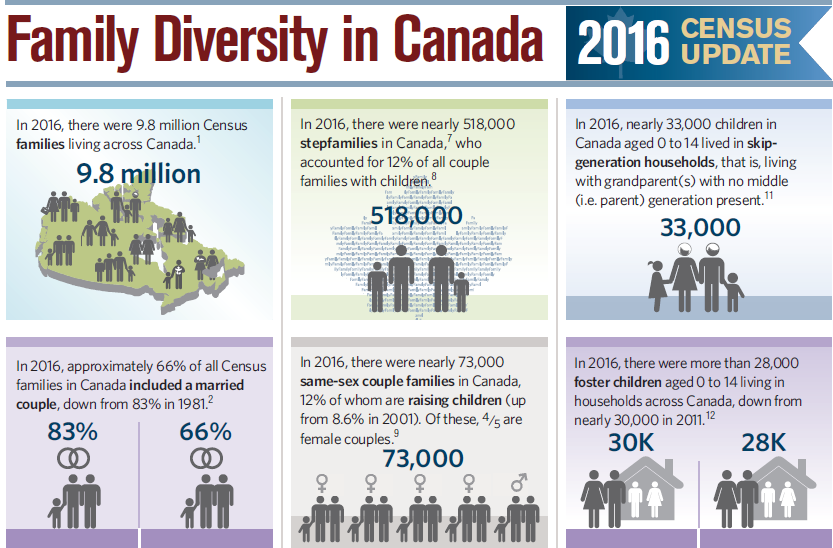
Image of 2016 family diversity in Canada
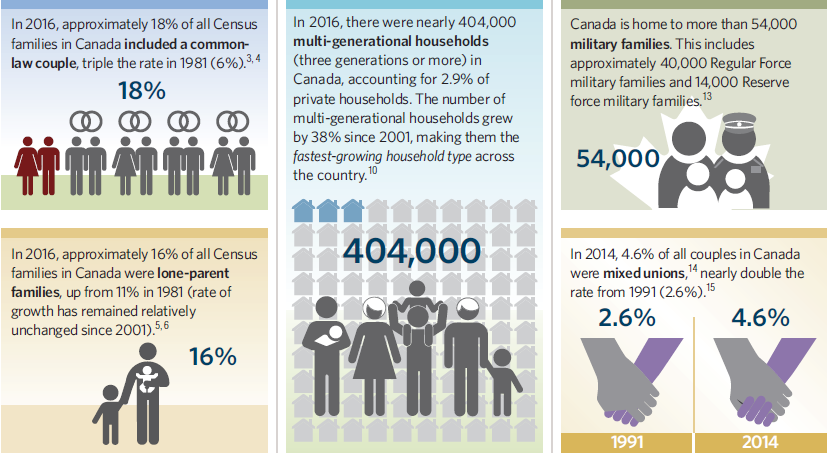
Infographics of family diversity in Canada
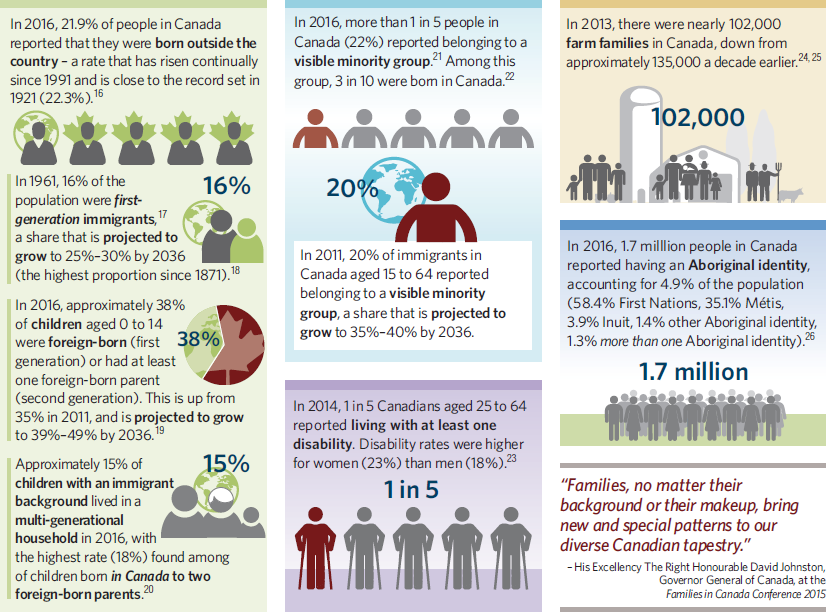
Infographics 2 of family diversity in Canada
See this
link for the full pdf.
Source:
Infographic: Family Diversity in Canada (2016 Census Update) from the Vanier Institute.
Photo by The Honest Company on Unsplash
Family and Work
Family and work is a topic that helps to see the intersection of the concepts of work, family, and gender. The division of labour has varied over human history depending on the economic system at the time. Currently, men and women experience work and family different, particularly in heterosexual relationships. Men and women have always worked to survive, but the way they divide that work has changed over time. Current research has focused on the division of labour in paid and non-paid work. Non-paid work is usually family related care of both dependant children and aging adults, and household responsibilities like cooking and cleaning.

Since these responsibilities do not provide direct economic rewards, they tend be marginalized and those doing the non-paid labour, tend to lack power in the relationship with a partner who does earn income from their work. Women do the bulk of domestic care, and as a result are disadvantaged in regard to economic power. If both your parents work outside the home, consider the last time you or one of your siblings was ill. Who usually stayed home from work to look after you? In most cases, it is the mother who does. How couples divide labour at home is a good indication of the equity of the relationship. Table 10.3 provides a good summary of Canadian data.
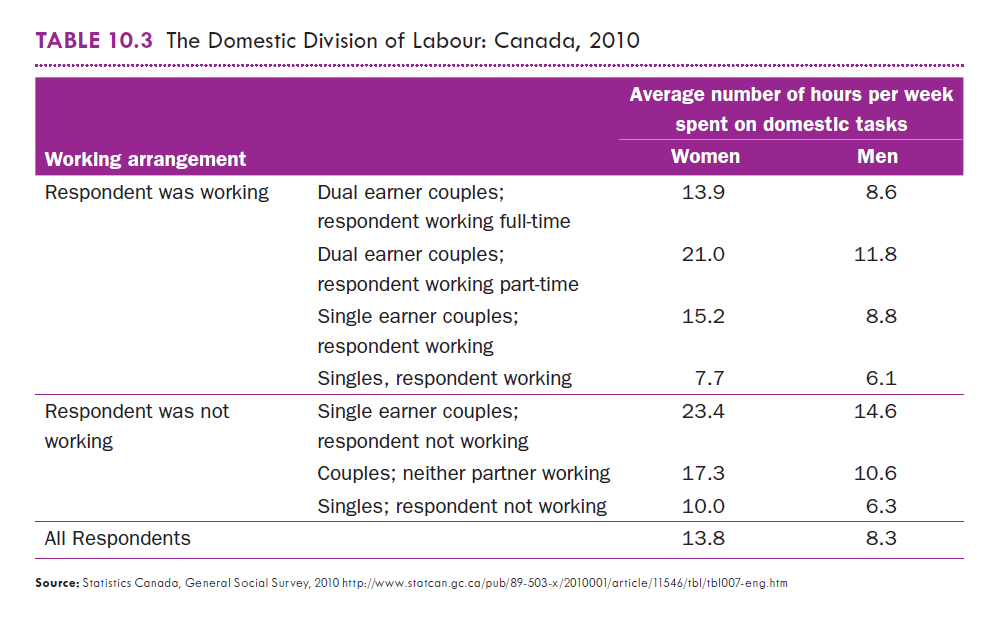
Functionalists, as we have seen, think family provides stability to society, and the research generally supports that family is good for our health. There are exceptions, as the family can be a place of terrible abuse, but generally, family life makes us happier and healthier than if we are alone or single.
Before you move on to the next topic, read the chapter on Family in your course textbook. Be sure to take notes as they will assist you in completing your assignments.
Education
Education is a social institution you are all well aware of or you would not be reading this right now. We often take education for granted as something that everyone does, but that is not true. Down through history most people were never formally educated, rather they learned the skills they needed to survive. Those who have had the opportunity for formal education were typically from high status families and their education perpetuated the class differences with most of society. Today, some form of education is available to most but not all. Sociologists see education as an important process in mitigating inequality in society. Education provides marketable skills, which in turn provides economic rewards. How many of you were told by your parents that education is the key to success? Your parents are not coming up with this idea on their own, they are also being influenced by society’s needs and goals. In a post-industrial world, skilled labour is needed. Formal education is society’s way of creating that workforce.
Questions to Consider
Research in Canada has shown that students from families with a household higher income are more likely to attend college or university than students from poorer families.
- Based on what you’ve learned so far, do you think difference would disappear if post secondary education were made cost-free to all interested students?
Academics
Once again, the different theories approach education differently. By now you should be able to begin to know how the theories will approach each topic. Functionalists see education as a means of socialization consistent with the goals and values of society. Public education, which is financed by tax dollars, is uniquely situated to teach and install values consistent with the social good. Teaching children to obey authority, value existing political, religious, and economic systems are all considered benefits to society because they lead to harmony and stability. Conflict theorists also see education as a successful socializing agent but their views are not as positive as the functionalists. Rather than providing a consistent and fair educational system that equips all student with reading and writing skills, this theory see inequality being perpetuated by the educational system. Conflict theorists see the hidden curriculum as one that reinforces upper class ways of viewing and experiencing the world.
Activity: College Bribery Scandal
The inequality in education is magnified when powerful people try to cheat the entrance system to prestigious universities. Read the wiki summary of a recent example of this and respond in your journal whether you think conflict theorists are right.
Bribery Scandal
Feminist theorists also see education as a powerful socializing agent and a way to help women gain more economic power, but their concern is that the system advantages males. Even with more women in higher education than men, feminist theorists would argue that women tend to be directed to less prestigious and economically profitable areas of study than men. They would also point to the male historical influence on the academy and suggest the influence of that continues to benefit men.
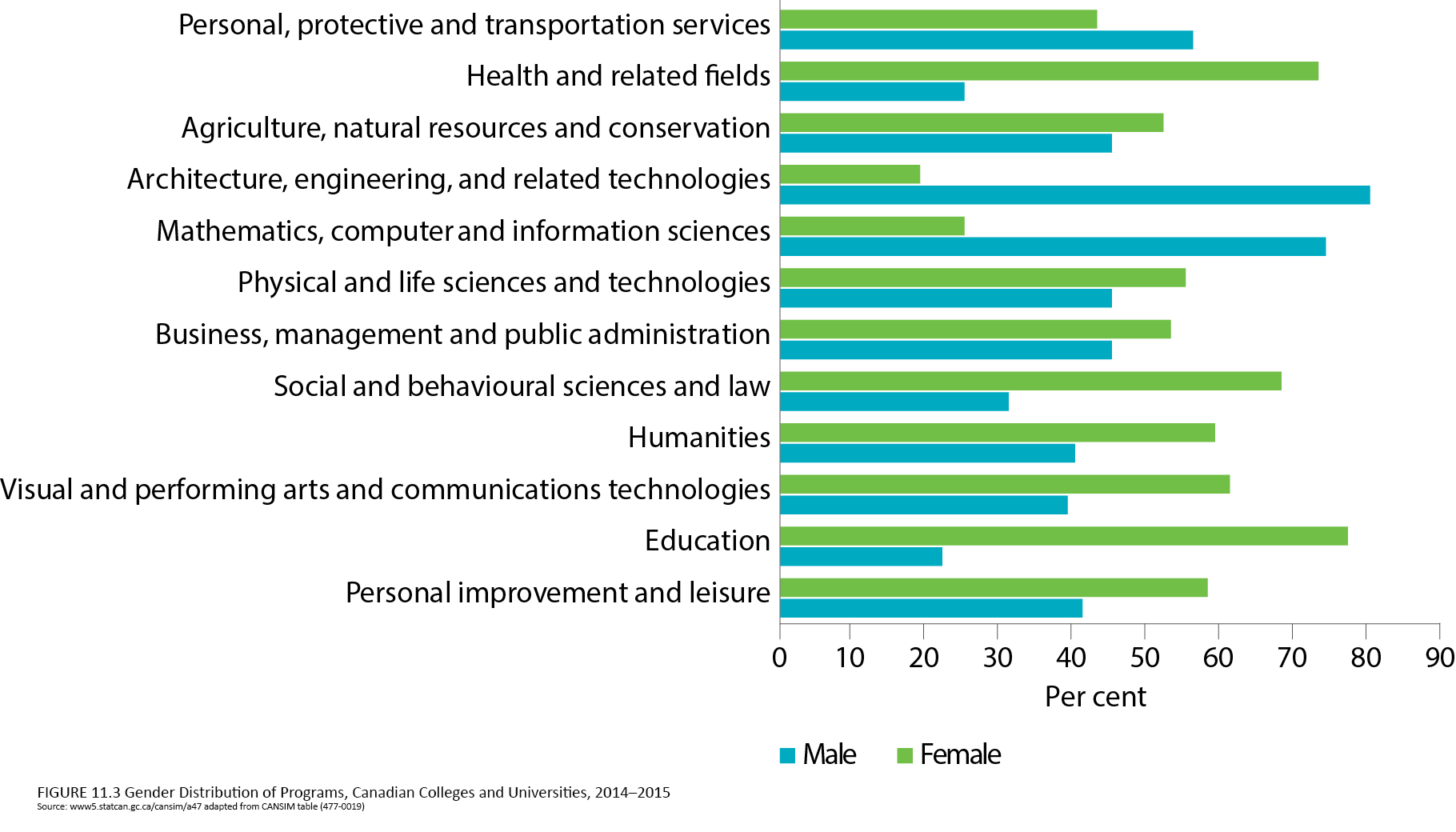
Symbolic interactionists are interested in how schools shape people’s identity and give them a sense of who they are. What happens if a teacher thinks one student is quite smart and capable while another has less ability? Will the teacher treat each student differently? Encourage one more than the other? Another area of interest may be the way a student performs based on how they perceive their ability or lack of ability.
Activity: Unequal Opportunities
Watch the video below and consider how the social environment can affect your educational opportunities. Can you think of how this might also play out in your own community?
Note that you may be asked to discuss this activity with your peers. Be sure to take notes and reflect on what you have learned.
Commodification
Higher education is big today. As societies become more education focused, the more educational institutions seek to control legitimacy of skills and credentials. The term credentialism reflects higher educations efforts to control who is officially recognized to have a skill. Historical higher education focused on the Liberal Arts as a way of providing education. The focus was not on preparing people for a specific job, but for being contributing citizens in society. This was mainly open to the upper class who were prepared to lead and govern society. Lower classes relied on hard work and the hopes of learning a skill or trade through an apprenticeship. Today, universities oversee the credentialing of many professions and occupations that historically would have been outside their realm. Business jobs, nursing and other professional programs are now run by universities. This approach is consistent with the economic focus that universities are increasingly driven by. The commodification of education reflects the idea that we buy degrees that open up opportunities to earn a living. This idea is also consistent with the increasing role of private corporations donating large amount of money to universities and benefiting financially from funded research at the highest level. Economic decisions are driving enrollment strategies and the increased presence of non-traditional delivery methods such as evening, weekend, or online delivery of content.
Questions to Consider
If you are reading this material then the previous issue of new forms of content delivery can not escape you.
- Take a few moments and consider why you are taking this class?
- What makes it better or worse than your other educational options and what suggestions would make to improve the course?
Streaming
Primary education is also very interesting to sociologists. Next to the family, early education may be the most influential in shaping a young person’s identity. The concepts of streaming or tracking are important to sociologists because they involve early structuring to an individual’s life course. Just like growing up in a poor or wealthy family will create different life experiences, so would being told you are smart or not so smart when you are young. Early labels can have a powerful effect on how you view yourself.
Activity: Tracking
Watch the brief video below and reflect on your own educational experience. Was there a time when you were placed in a certain group that had higher or lower expectations than the rest of the class?
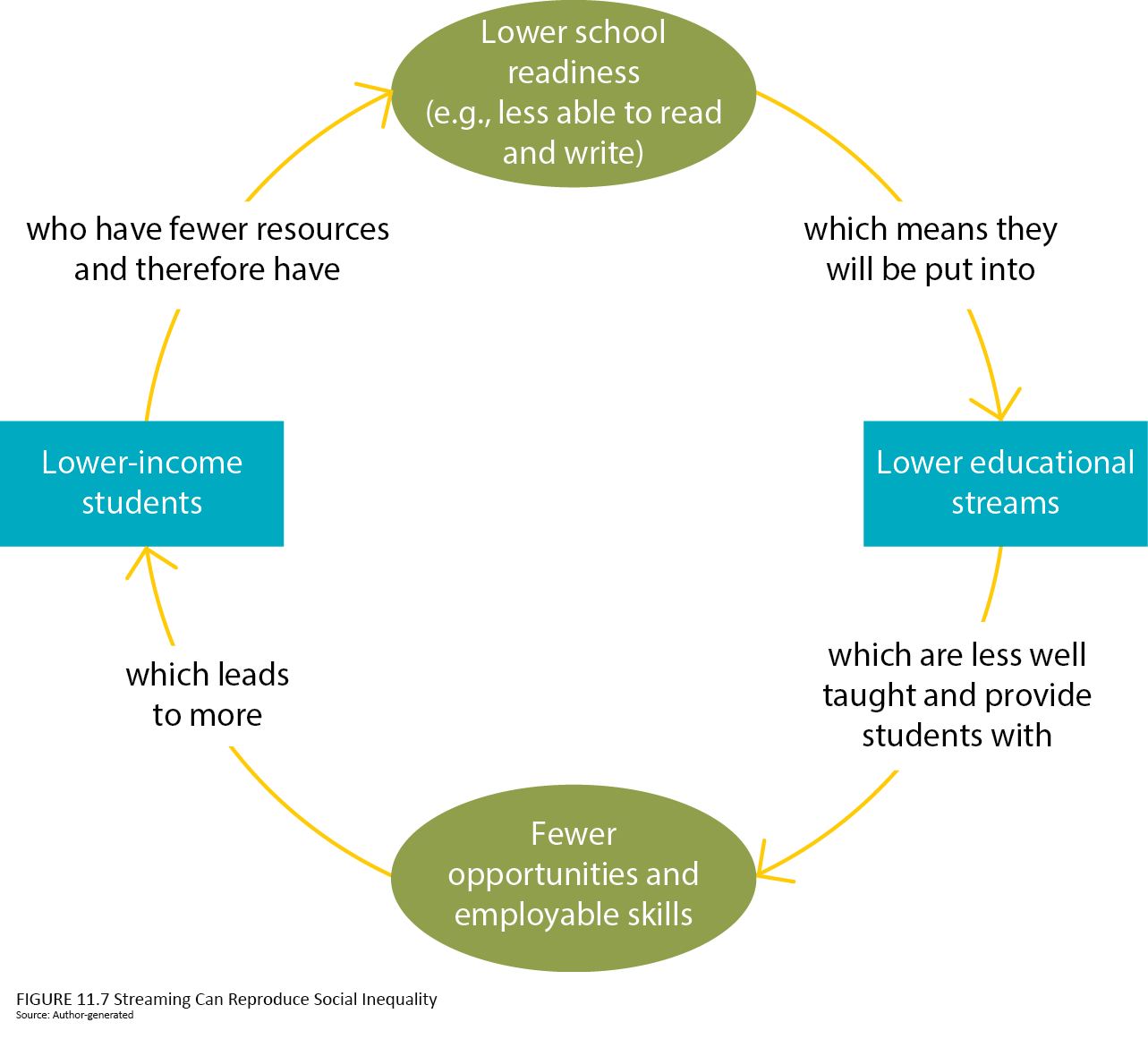
Cyclic chart showing streaming can reproduce social iequality
The educational system is a broad institution. People experience it at many social levels. The desire to go to university is less your own and more a product of an economic system that favours it. On the school grounds you are influenced by social actors and situations. It is a learning ground of how society works. Some would say it where we learn everything we need to know.
Activity: Everything You Need to Know
Read the following poem and reflect on how it applies to your beliefs and experiences.
All I Really Need To Know I Learned In Kindergarten
by Robert Fulghum
Most of what I really need
To know about how to live
And what to do and how to be
I learned in kindergarten.
Wisdom was not at the top
Of the graduate school mountain,
But there in the sandpile at Sunday school.
These are the things I learned:
Share everything.
Play fair.
Don’t hit people.
Put things back where you found them.
Clean up your own mess.
Don’t take things that aren’t yours.
Say you’re sorry when you hurt somebody.
Wash your hands before you eat.
Flush.
Warm cookies and cold milk are good for you.
Live a balanced life -
Learn some and think some
And draw and paint and sing and dance
And play and work everyday some.
Take a nap every afternoon.
When you go out into the world,
Watch out for traffic,
Hold hands and stick together.
Be aware of wonder.
Work and the Economy
Industrialization
Work and the economy are main drivers of social behaviour. Marx believed it to be so and developed his entire conflict theory around economic factors. The emergence of sociology as a discipline took place in Europe during the 19th century. This was a time of great social change, and one area that was driving the social change was the changing economic environment. Industrialization was changing where people lived, their family size, what they did to earn a living, and the separation of work and home life with men going off to work and women staying home – just to name a few of the changes.
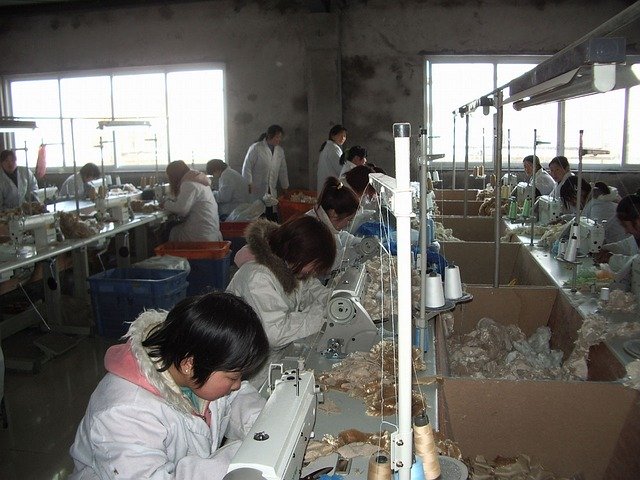
Photo credit: Pixabay
Industrial societies are centered around industrial production. The workforce needs labourers and the economy needs consumers. Some sociologists believe that industrialization through modernization is inevitable and that all cultures move from less developed to more developed. This is called the convergence thesis and it states that development leads to similar cultural outcomes.
Activity: Convergence Thesis
Watch the video below to see some real data being used to make the argument of convergence. After watching, you’ll be asked to reflect with your peers on how industrialization has changed your culture and consequently, your life.
Organization of Work
Industrialization doesn’t just happen; there are processes that need to take place in order for it happen. Ideas such as division of labour and specialization discuss the move from people having a general knowledge about how to survive, to one that requires special skills and knowledge that are too great for any one person to posses. This led to the need for people to work together in order to achieve a greater goal than any one person could do on their own. This not only made societies more productive but it also held societies together. Complete the two learning activities listed below and ask yourself if you think organic or mechanical solidarity is better and why?
Activity: Organic and Mechanical Solidarity
Watch Organic and Mechanical Solidarity, a brief part of “The American Road” a 1953 documentary sponsored by Ford Motor Company.
Not everyone sees modernization as a positive development. Karl Marx witnessed greater inequality and suffering in society as a result of industrialization and felt that workers were being alienated from meaningful work as they worked in factories in poor conditions for poor wages. He saw the factory owners getting wealthy while the factory workers barely survived. Even in office environments this kind of alienation can take place. Bureaucracy is the process of breaking down a task to small pieces that can then be done more efficiently than trying to do many different tasks. This can be in manufacturing, office environments or computer coding. The problem is that this type of efficiency may work well for machines but not for human beings who may get bored or careless.
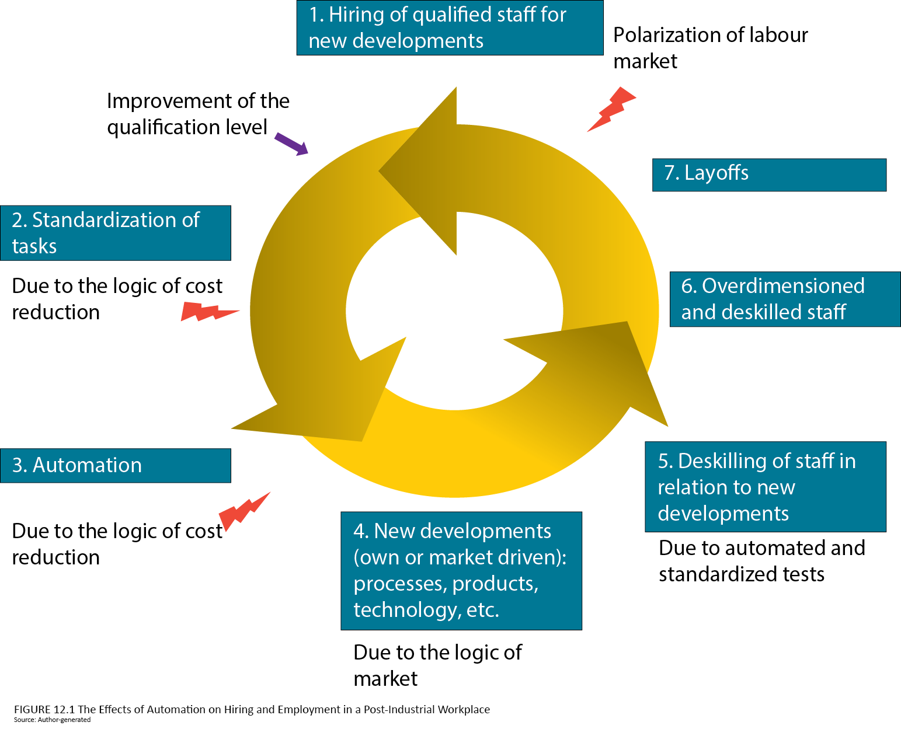
Questions to Consider
- Take a moment and consider the difference between an efficient work environment and an effective work environment. Which would you rather work in?
Technology
Efficiency also brings up issues of automation. Machines have been replacing human effort for as long as human history has existed. Today we see a rise in robotics and artificial intelligence that threaten to eliminate many of todays occupations.
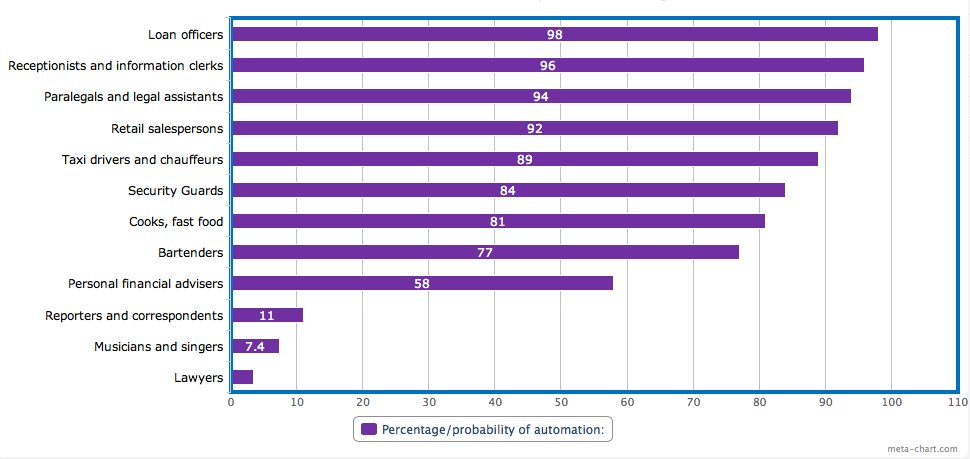
Globalization and Feminization
A combination of modernization, globalization, and the spread of neo-liberal economic policies continue to work and the social organization of it. As multinational corporations seek to find ways of cutting costs and increasing shareholder value, workers are caught in the middle. Global trade agreements, trade wars, and trade tariffs are all part of the world in which the parts are more connected than ever. Workers migrate to opportunities within their own country and around the world if they possess the resources and skills needed. For those who don’t have such resources, non-standard work is becoming more expected of low skill labour. Non-standard work falls outside the typical 9-5 work day and Monday to Friday work week. Some non-standard jobs are high status jobs like medical doctors, but most are menial and precarious jobs working in service industries and retail environments. Many of these jobs are filled by women who lack the human capital to access more desirable jobs.
Karl Marx saw a society that was very unequal. He saw workers selling their labour at survival rates while factory owners got wealthy. He felt that low class workers would need to unite politically and with trade unions in order to have the power to influence the owners. Political parties that aligned with workers’ needs also supported the trade unions that allowed workers to have a collective voice in seeking fair, equitable, and safe working conditions. The one thing Marx did not anticipate was the progressive rise of the middle class who financially benefitted from the growing economy. We see this trend continuing with the decrease in the role of unions in negotiating on behalf of workers.
Questions to Consider
Based on what you have learned so far in this course,
- What do you think will be the future of workers?
- Will conditions continue to improve and the inequality between the have and have-nots decrease, or could you see it being the other way around?
Religion
What Is It?
Next to the family, religion is a powerful socializing institution. Its potential life-long influence and strong emphasis on adherence to specific beliefs and behaviours allows religion to influence at both the individual and social levels.
Religion can also be a very polarizing topic because of its emphasis on beliefs and behaviours. It is also controversial because religious issues tend to be contrasted to science and positivism. From a sociological perspective, it is important to understand that a person does not have to be religious in order to understand the power of religion on human behaviour.
All the major theoretical positions of sociology have something to say about religion. It is important to remember the historical and social context in which sociology came to be recognized as a legitimate academic discipline. In the 19th century, science was the dominant epistemology (ways of knowing) for the academic community. The major founders of sociology were all influenced by religion from their family background but none were known to adhere to any major faith tradition. Although none were religious, all studied religion, which makes the definition important. What is religion? What is religiosity? How is it different from spirituality? And perhaps most perplexing to the early sociologists, why is still such a dominant social institution over a century after many thought it would die out?
Activity: What is Religious?
Note that you may be asked to discuss this activity with your peers. Be sure to take notes and reflect on what you have learned.
Trends in Religious Beliefs
We can see that religion is more than just the world religions that we may be familiar with. When most people think of religion, they think of religious beliefs and behaviours that are associated with religions. Things like prayers and attending a synagogue, church, mosque, or temple. When religion is depicted as just a belief in the supernatural, it is positioned as the opposite of science and the empirical method in which we use our five senses to determine truth, not our heart or soul.
Each major theory adds to our sociological vocabulary as they discuss the topic of religion. Functionalists see religion as providing cohesion and stability to a society. Emile Durkeheim felt that the division of society was based on the religious concepts of sacred and profane. He felt that religion divided the world into two categories: the things that belonged to religion were sacred, and the rest of the world was profane. Those with religious jobs had sacred jobs, days of worship, or places of worship that were sacred – the rest profane.
Functionalism sees religion as providing helpful restraints to negative social behaviours like lawlessness and addiction, and helpful in regulating sexual expression in society. Karl Marx was anti-religion. He felt that religion was a form of control that the ruling class used to keep the lower classes content in their poor living circumstances. He referred to religion as “the opiate of the masses” referring to the way religion acted like a drug to keep people from rising up against unfair working and living conditions.
Max Weber thought that religious beliefs could have an impact on the way economic systems emerged. He felt that certain protestant beliefs, when practiced by enough individuals, led to the rise of capitalism when and where it did. Symbolic interaction also looks at religion for its symbolism. Religious symbols such as crosses or Kirpans carry meaning for religious believers but not for others. Different religions have different sacred days and festivals which all carry meaning to the adherents.
Remember that symbols are a form of communication and their meaning is the result of a community agreeing on the message the symbol is sending.

Symbols image from Pixabay
Activity: Religious Symbols
Select three symbols from the diagram above and write a brief statement about what the symbols mean to the group who uses it.
Secularization and Fundamentalism
Early proponents of sociology saw it as a move away from faith and myth into a more scientific age. With the rise of the impact of the scientific method, religion was viewed to be losing its influence on shaping peoples’ behaviour. Secularization is the process of a society focusing less on the sacred and more on the profane or secular aspects of society. Many of the tasks that religious communities took a lead in are now being done by private or government agencies. Examples of this would be education, health care, care for the poor and elderly. Religion tends to have a decreasing impact on the lives of most people but that is not to say religion is still not an important and influential part of society. In contrast to secularization, in which religion is perceived to becoming less important, fundamentalism, a strict view of religious adherence, is quite strong across most world religions.
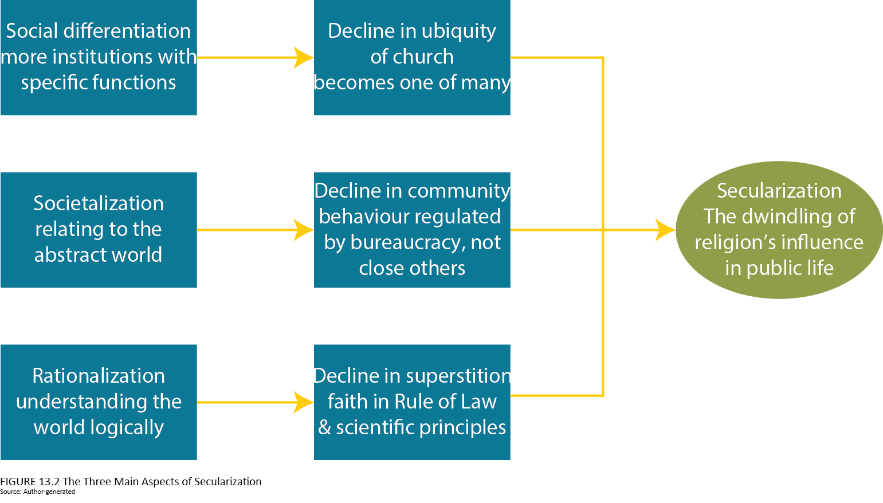
The Religion vs. Science Debate
The ideas of secularization and fundamentalism are two approaches to religion that go in the opposite direction and may in fact feed off one another. This dichotomy can be understood by looking at the science vs. faith debate. Can a scientist also be religious? Some sociologists suggest that the tension between science and faith may be the result of thinking one or the other can answer all the big questions of life. Max Weber viewed the scientist as the modern-day priest, which may explain why some think the two ideas cannot be harmonized.

Source: Pixaby Lab Technician and A Buddhist Monk
Questions to Consider
Take a moment to think about sacred and profane, faith and science, or secularization and fundamentalism.
- What questions is religion better able to answer than science, and vice versa?
Religion and Politics
We have discussed how social institutions shape human behaviour. We have seen how Max Weber thought it could give birth to an economic system. One way in which religious institutions shape society is through public services and political activism on behalf of the needy, and causes that are consistent with their beliefs. Organizations like the Red Cross and Red Crescent are examples of how religious organizations try to influence the world through humanitarian aid.
New Religious Movements
How new religions come into existence and transform over time is explained by the church typology. This typology suggests that new movements tend to start out without much organization or structure and often with counter social views. As the organization grows it becomes more bureaucratic and more imbedded into society. This process involves changes in leadership styles, literal interpretation of sacred texts, organizational structures, and relationships with the world around them.
Activity: Church Typology
Examine the chart below and consider how various religious organizations are classified. If you want to know more about this topic, refer to your textbook or do a google search (e.g. Sociological classifications of religious movements from Wikipedia).
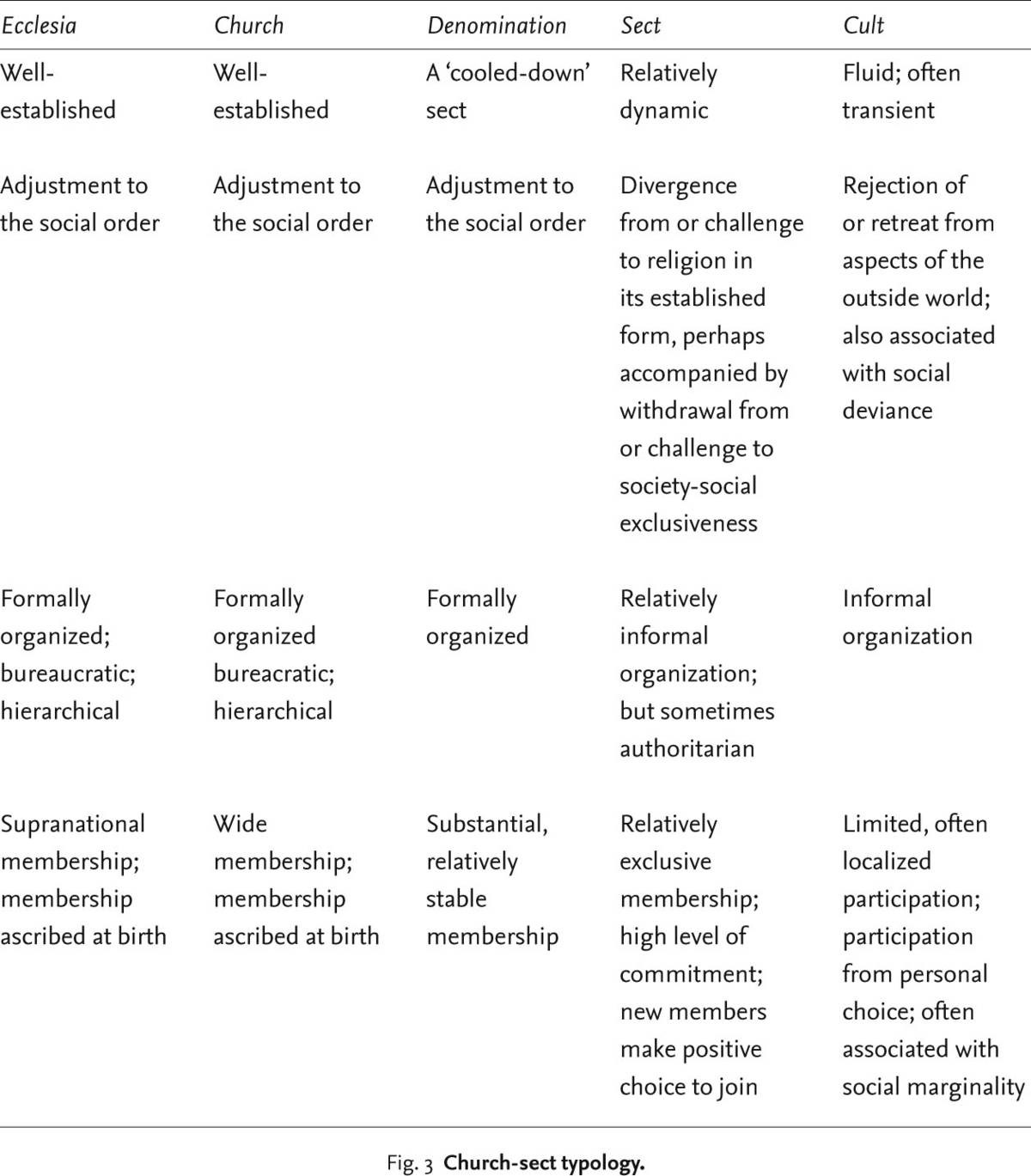
Chart of Church-sect typology
Summary
In Unit 5, you were exposed to five powerful socializing agents: family, education, work, religion, and the media. These are not the only institutions that we experience in our social world, but they do give us a good overview of how institutions we often take for granted, and shape our social experience.
The family socializes us early and often which creates a strong initial experience and lens for seeing the rest of the world. Parents often perpetuate their values through their children by channelling them into other institutions like education. Education is another early socializer, and as a result is quite influential in shaping the way see other aspects of the world around us. The government likes to use public schools to perpetuate what it means to be a good citizen. Educational socialization has a manifest or outward goal to teach basic academic skills and knowledge. But education has a latent agenda as well. We learn a lot of the world in the school yard, and maybe obedience to authority and embracing a certain world view of economic and political structure is more important than reading and writing. Education is meant to prepare us for adulthood and to enter the market places of our economy. Work shapes the need for specific types of education and technology is pushing us to need a more digitally skilled worker than previous economies. Religion is often contrasted to science but many feel they address different questions and should not be viewed as fighting for the social same territory. Religion is a powerful socializer because of its emphasis on beliefs that are meant to influence behaviours. Finally, we looked at mass and social media as intuitional tools to inform, influence, and shape our views of the world around us. You also saw the urgent need to improve our training and skills in dealing with an unprecedented amount of information in order to benefit from it rather than be manipulated by it.
Assessment
Quizzes 10-14
After completing this unit, including the learning activities, you are asked to complete the online quiz reviewing material from chapter 15.
Each chapter quiz is worth 1% of your grade.
Go to Quizzes in the main Assessment tab for access to Quiz 15. Note that the quizzes will be administered in the Learning Lab.
Be sure to practice with the online quizzes from the textbook.
Assignment: Reflective Journal
The Reflective Journal assignment is a chance to present your understanding and application of the course material, ask questions, and clarify issues. We are looking for evidence that you are engaging the course material. Examine the learning outcomes for each unit and ensure that your journal addresses each outcome. Include your thoughts from the learning activities and how you apply the concepts to your life and current events.
Refer to the Assessment section in Moodle for all other assignment details and due dates.
Unit 5 Social Institutions
Overview
Social institutions will form the basis of Unit Five. We select five key social institutions to illustrate this topic. We begin with a look at family and seek to understand its importance in early socialization. Next we look at education and its role in shaping the social perceptions and behaviour of society. Work and the economy follow in a life course sequence. Education prepares us for work and involvement in the economy, but our work and the economic system around us also shapes our behaviour. Religion is viewed by some theorists as influencing the origin of our social world. We look at religion in its formal and informal influences. Finally, for the purposes of this unit, we look at the role of mass and social media in shaping the world we live in. We will be introduced to the idea of media and see how as it has evolved, so how the way it which it shapes human behaviour.
Topics
This unit is divided into the following topics:
Learning Outcomes
When you have completed this unit, you should be able to:
Activity Checklist
Here is a checklist of learning activities you will benefit from in completing this unit. You may find it useful for planning your work.
Learning Activities
Assessment
Resources
Here are the resources you will need to complete this unit.
5.1 Family
The importance of the family as a socializing institution has already been discussed earlier in the course. In this section, we look at more specific features of the family and how sociologists study it. We are going to begin with a section on defining what the family is, how it has changed, and is changing. We will then look at how the family interactions with other institutions is shaping and being shaped by them. We are going to look at family and work and family and health in this section.
Defining the Family
Theoretical perspectives take different views of the family. Functionalists consider the family to be an important institution in creating social stability as it is used to regulate human behaviour and provide motivation and encouragement of pro-social behaviour. Early family sociologists, like Durkheim, saw the family as serving an important function in society, and was concerned about increased individuality and its potential negative effects. Conflict theorists see the family as a micro-expression of the conflict found in society-at-large. The hierarchy of family members that is often present in cultures is where conflict theorists feel that inequality is nurtured and promoted. Feminist scholars agree with the conflict perspective and see the inequality in families as being along gendered lines. They would point to the almost universal presence of patriarchy in family structures in which men have more power and authority than women. Symbolic interactionists are concerned about how families develop certain values and interpret what it means to be a good husband or good wife. Each of these theories provides a unique and valuable perspective on the study of family.
Perhaps more controversial than we think, defining what a family is and isn’t, stirs up strong feelings in society and in the academic community. Down through history, family has meant many things. Today, most think of the family as being made up of two people with their children. Anthropologists know that many forms of families have existed across time and cultures, but the nuclear family has been most prevalent around the world. It should be understood that historically, family forms and function had been focused on survival rather than personal fulfillment. People partnered in order to procreate and increase their likelihood of survival, and also to ensure care in the later years of life. Today, social safety nets, like old age government services, have been introduced in most countries to ensure people with needs do not fall through the social care cracks.
Activity: Defining the Family
Here is an exercise that will help you gain a better appreciation for the importance of defining family. Take a look at this list and consider which you would count as a family. Can you think of some other examples that you would consider a family but it is not listed?
Questions to Consider
How many of the following statements would you count as a family? Add your total up and compare with your classmates.
Total ____________
Source; White and Klein, 1996
Family Change
Family forms have been influenced by a variety of factors, but technological change has been continually linked to family change and in particular, family forms. When families needed to continually move to new food sources, they needed to be small and mobile and tended to have few children. When technologies allowed families to reside in one place, family sizes tended to get bigger since children provided economic benefits by helping on the farm. Agrarian families tended to be quite large. During the industrial revolution, many families were displaced from land and had to move to cities and work in factories to earn a living. Crowed living quarters and child labour laws made children an economic liability and so family size began to get smaller. Today, with increased medical advancement and better living conditions, people are more likely to live longer healthier lives. They can interact with multiple generation of kin. Scientific advancement has led to test tube babies and surrogate motherhood. These advancements create opportunities for same-sex couples to have their own biological children, and give an insight into what the future might bring.
Activity: Children and Happiness
Read the article below and consider why we have children today and what you think about people who choose to have no children?
Image of a child laughing
Does having children make people happier in the long run?, Wolfinger (2020), Institute for Family Studies.
Note that you may be asked to discuss this activity with your peers. Be sure to take notes and reflect on what you have learned.
Activity: Family Diversity
Do a little research on your own to find out what diverse family structures look like in your country. How do they differ from Canadian data listed below?
Image of 2016 family diversity in Canada
Infographics of family diversity in Canada
Infographics 2 of family diversity in Canada
See this link for the full pdf. Source: Infographic: Family Diversity in Canada (2016 Census Update) from the Vanier Institute.Photo by The Honest Company on Unsplash
Family and Work
Family and work is a topic that helps to see the intersection of the concepts of work, family, and gender. The division of labour has varied over human history depending on the economic system at the time. Currently, men and women experience work and family different, particularly in heterosexual relationships. Men and women have always worked to survive, but the way they divide that work has changed over time. Current research has focused on the division of labour in paid and non-paid work. Non-paid work is usually family related care of both dependant children and aging adults, and household responsibilities like cooking and cleaning.
Since these responsibilities do not provide direct economic rewards, they tend be marginalized and those doing the non-paid labour, tend to lack power in the relationship with a partner who does earn income from their work. Women do the bulk of domestic care, and as a result are disadvantaged in regard to economic power. If both your parents work outside the home, consider the last time you or one of your siblings was ill. Who usually stayed home from work to look after you? In most cases, it is the mother who does. How couples divide labour at home is a good indication of the equity of the relationship. Table 10.3 provides a good summary of Canadian data.
Functionalists, as we have seen, think family provides stability to society, and the research generally supports that family is good for our health. There are exceptions, as the family can be a place of terrible abuse, but generally, family life makes us happier and healthier than if we are alone or single.
Before you move on to the next topic, read the chapter on Family in your course textbook. Be sure to take notes as they will assist you in completing your assignments.
5.2 Education
Education is a social institution you are all well aware of or you would not be reading this right now. We often take education for granted as something that everyone does, but that is not true. Down through history most people were never formally educated, rather they learned the skills they needed to survive. Those who have had the opportunity for formal education were typically from high status families and their education perpetuated the class differences with most of society. Today, some form of education is available to most but not all. Sociologists see education as an important process in mitigating inequality in society. Education provides marketable skills, which in turn provides economic rewards. How many of you were told by your parents that education is the key to success? Your parents are not coming up with this idea on their own, they are also being influenced by society’s needs and goals. In a post-industrial world, skilled labour is needed. Formal education is society’s way of creating that workforce.
Questions to Consider
Research in Canada has shown that students from families with a household higher income are more likely to attend college or university than students from poorer families.
Academics
Once again, the different theories approach education differently. By now you should be able to begin to know how the theories will approach each topic. Functionalists see education as a means of socialization consistent with the goals and values of society. Public education, which is financed by tax dollars, is uniquely situated to teach and install values consistent with the social good. Teaching children to obey authority, value existing political, religious, and economic systems are all considered benefits to society because they lead to harmony and stability. Conflict theorists also see education as a successful socializing agent but their views are not as positive as the functionalists. Rather than providing a consistent and fair educational system that equips all student with reading and writing skills, this theory see inequality being perpetuated by the educational system. Conflict theorists see the hidden curriculum as one that reinforces upper class ways of viewing and experiencing the world.
Activity: College Bribery Scandal
The inequality in education is magnified when powerful people try to cheat the entrance system to prestigious universities. Read the wiki summary of a recent example of this and respond in your journal whether you think conflict theorists are right.
Bribery Scandal
Feminist theorists also see education as a powerful socializing agent and a way to help women gain more economic power, but their concern is that the system advantages males. Even with more women in higher education than men, feminist theorists would argue that women tend to be directed to less prestigious and economically profitable areas of study than men. They would also point to the male historical influence on the academy and suggest the influence of that continues to benefit men.
Symbolic interactionists are interested in how schools shape people’s identity and give them a sense of who they are. What happens if a teacher thinks one student is quite smart and capable while another has less ability? Will the teacher treat each student differently? Encourage one more than the other? Another area of interest may be the way a student performs based on how they perceive their ability or lack of ability.
Activity: Unequal Opportunities
Watch the video below and consider how the social environment can affect your educational opportunities. Can you think of how this might also play out in your own community?
Note that you may be asked to discuss this activity with your peers. Be sure to take notes and reflect on what you have learned.
Commodification
Higher education is big today. As societies become more education focused, the more educational institutions seek to control legitimacy of skills and credentials. The term credentialism reflects higher educations efforts to control who is officially recognized to have a skill. Historical higher education focused on the Liberal Arts as a way of providing education. The focus was not on preparing people for a specific job, but for being contributing citizens in society. This was mainly open to the upper class who were prepared to lead and govern society. Lower classes relied on hard work and the hopes of learning a skill or trade through an apprenticeship. Today, universities oversee the credentialing of many professions and occupations that historically would have been outside their realm. Business jobs, nursing and other professional programs are now run by universities. This approach is consistent with the economic focus that universities are increasingly driven by. The commodification of education reflects the idea that we buy degrees that open up opportunities to earn a living. This idea is also consistent with the increasing role of private corporations donating large amount of money to universities and benefiting financially from funded research at the highest level. Economic decisions are driving enrollment strategies and the increased presence of non-traditional delivery methods such as evening, weekend, or online delivery of content.
Questions to Consider
If you are reading this material then the previous issue of new forms of content delivery can not escape you.
Streaming
Primary education is also very interesting to sociologists. Next to the family, early education may be the most influential in shaping a young person’s identity. The concepts of streaming or tracking are important to sociologists because they involve early structuring to an individual’s life course. Just like growing up in a poor or wealthy family will create different life experiences, so would being told you are smart or not so smart when you are young. Early labels can have a powerful effect on how you view yourself.
Activity: Tracking
Watch the brief video below and reflect on your own educational experience. Was there a time when you were placed in a certain group that had higher or lower expectations than the rest of the class?
Cyclic chart showing streaming can reproduce social iequality
The educational system is a broad institution. People experience it at many social levels. The desire to go to university is less your own and more a product of an economic system that favours it. On the school grounds you are influenced by social actors and situations. It is a learning ground of how society works. Some would say it where we learn everything we need to know.
Activity: Everything You Need to Know
Read the following poem and reflect on how it applies to your beliefs and experiences.
All I Really Need To Know I Learned In Kindergarten
by Robert Fulghum
5.3 Work and the Economy
Industrialization
Work and the economy are main drivers of social behaviour. Marx believed it to be so and developed his entire conflict theory around economic factors. The emergence of sociology as a discipline took place in Europe during the 19th century. This was a time of great social change, and one area that was driving the social change was the changing economic environment. Industrialization was changing where people lived, their family size, what they did to earn a living, and the separation of work and home life with men going off to work and women staying home – just to name a few of the changes.
Photo credit: Pixabay
Industrial societies are centered around industrial production. The workforce needs labourers and the economy needs consumers. Some sociologists believe that industrialization through modernization is inevitable and that all cultures move from less developed to more developed. This is called the convergence thesis and it states that development leads to similar cultural outcomes.
Activity: Convergence Thesis
Watch the video below to see some real data being used to make the argument of convergence. After watching, you’ll be asked to reflect with your peers on how industrialization has changed your culture and consequently, your life.
Organization of Work
Industrialization doesn’t just happen; there are processes that need to take place in order for it happen. Ideas such as division of labour and specialization discuss the move from people having a general knowledge about how to survive, to one that requires special skills and knowledge that are too great for any one person to posses. This led to the need for people to work together in order to achieve a greater goal than any one person could do on their own. This not only made societies more productive but it also held societies together. Complete the two learning activities listed below and ask yourself if you think organic or mechanical solidarity is better and why?
Activity: Organic and Mechanical Solidarity
Watch Organic and Mechanical Solidarity, a brief part of “The American Road” a 1953 documentary sponsored by Ford Motor Company.
Not everyone sees modernization as a positive development. Karl Marx witnessed greater inequality and suffering in society as a result of industrialization and felt that workers were being alienated from meaningful work as they worked in factories in poor conditions for poor wages. He saw the factory owners getting wealthy while the factory workers barely survived. Even in office environments this kind of alienation can take place. Bureaucracy is the process of breaking down a task to small pieces that can then be done more efficiently than trying to do many different tasks. This can be in manufacturing, office environments or computer coding. The problem is that this type of efficiency may work well for machines but not for human beings who may get bored or careless.
Questions to Consider
Technology
Efficiency also brings up issues of automation. Machines have been replacing human effort for as long as human history has existed. Today we see a rise in robotics and artificial intelligence that threaten to eliminate many of todays occupations.
Globalization and Feminization
A combination of modernization, globalization, and the spread of neo-liberal economic policies continue to work and the social organization of it. As multinational corporations seek to find ways of cutting costs and increasing shareholder value, workers are caught in the middle. Global trade agreements, trade wars, and trade tariffs are all part of the world in which the parts are more connected than ever. Workers migrate to opportunities within their own country and around the world if they possess the resources and skills needed. For those who don’t have such resources, non-standard work is becoming more expected of low skill labour. Non-standard work falls outside the typical 9-5 work day and Monday to Friday work week. Some non-standard jobs are high status jobs like medical doctors, but most are menial and precarious jobs working in service industries and retail environments. Many of these jobs are filled by women who lack the human capital to access more desirable jobs.
Karl Marx saw a society that was very unequal. He saw workers selling their labour at survival rates while factory owners got wealthy. He felt that low class workers would need to unite politically and with trade unions in order to have the power to influence the owners. Political parties that aligned with workers’ needs also supported the trade unions that allowed workers to have a collective voice in seeking fair, equitable, and safe working conditions. The one thing Marx did not anticipate was the progressive rise of the middle class who financially benefitted from the growing economy. We see this trend continuing with the decrease in the role of unions in negotiating on behalf of workers.
Questions to Consider
Based on what you have learned so far in this course,
5.4 Religion
What Is It?
Next to the family, religion is a powerful socializing institution. Its potential life-long influence and strong emphasis on adherence to specific beliefs and behaviours allows religion to influence at both the individual and social levels.
Religion can also be a very polarizing topic because of its emphasis on beliefs and behaviours. It is also controversial because religious issues tend to be contrasted to science and positivism. From a sociological perspective, it is important to understand that a person does not have to be religious in order to understand the power of religion on human behaviour.
All the major theoretical positions of sociology have something to say about religion. It is important to remember the historical and social context in which sociology came to be recognized as a legitimate academic discipline. In the 19th century, science was the dominant epistemology (ways of knowing) for the academic community. The major founders of sociology were all influenced by religion from their family background but none were known to adhere to any major faith tradition. Although none were religious, all studied religion, which makes the definition important. What is religion? What is religiosity? How is it different from spirituality? And perhaps most perplexing to the early sociologists, why is still such a dominant social institution over a century after many thought it would die out?
Activity: What is Religious?
Before we get going too far in this topic, watch the videos below and ask yourself, which one(s) are religious?
Watch: “Sandstorm” before kickoff - South Carolina Gamecocks vs. Georgia - 2012
Watch: Queen - We Are The Champions (Live Aid 1985)
Watch: 5 largest religious gatherings in the world
Note that you may be asked to discuss this activity with your peers. Be sure to take notes and reflect on what you have learned.
Trends in Religious Beliefs
We can see that religion is more than just the world religions that we may be familiar with. When most people think of religion, they think of religious beliefs and behaviours that are associated with religions. Things like prayers and attending a synagogue, church, mosque, or temple. When religion is depicted as just a belief in the supernatural, it is positioned as the opposite of science and the empirical method in which we use our five senses to determine truth, not our heart or soul.
Each major theory adds to our sociological vocabulary as they discuss the topic of religion. Functionalists see religion as providing cohesion and stability to a society. Emile Durkeheim felt that the division of society was based on the religious concepts of sacred and profane. He felt that religion divided the world into two categories: the things that belonged to religion were sacred, and the rest of the world was profane. Those with religious jobs had sacred jobs, days of worship, or places of worship that were sacred – the rest profane.
Functionalism sees religion as providing helpful restraints to negative social behaviours like lawlessness and addiction, and helpful in regulating sexual expression in society. Karl Marx was anti-religion. He felt that religion was a form of control that the ruling class used to keep the lower classes content in their poor living circumstances. He referred to religion as “the opiate of the masses” referring to the way religion acted like a drug to keep people from rising up against unfair working and living conditions.
Max Weber thought that religious beliefs could have an impact on the way economic systems emerged. He felt that certain protestant beliefs, when practiced by enough individuals, led to the rise of capitalism when and where it did. Symbolic interaction also looks at religion for its symbolism. Religious symbols such as crosses or Kirpans carry meaning for religious believers but not for others. Different religions have different sacred days and festivals which all carry meaning to the adherents.
Remember that symbols are a form of communication and their meaning is the result of a community agreeing on the message the symbol is sending.
Symbols image from Pixabay
Activity: Religious Symbols
Select three symbols from the diagram above and write a brief statement about what the symbols mean to the group who uses it.
Secularization and Fundamentalism
Early proponents of sociology saw it as a move away from faith and myth into a more scientific age. With the rise of the impact of the scientific method, religion was viewed to be losing its influence on shaping peoples’ behaviour. Secularization is the process of a society focusing less on the sacred and more on the profane or secular aspects of society. Many of the tasks that religious communities took a lead in are now being done by private or government agencies. Examples of this would be education, health care, care for the poor and elderly. Religion tends to have a decreasing impact on the lives of most people but that is not to say religion is still not an important and influential part of society. In contrast to secularization, in which religion is perceived to becoming less important, fundamentalism, a strict view of religious adherence, is quite strong across most world religions.
The Religion vs. Science Debate
The ideas of secularization and fundamentalism are two approaches to religion that go in the opposite direction and may in fact feed off one another. This dichotomy can be understood by looking at the science vs. faith debate. Can a scientist also be religious? Some sociologists suggest that the tension between science and faith may be the result of thinking one or the other can answer all the big questions of life. Max Weber viewed the scientist as the modern-day priest, which may explain why some think the two ideas cannot be harmonized.
Source: Pixaby Lab Technician and A Buddhist Monk
Questions to Consider
Take a moment to think about sacred and profane, faith and science, or secularization and fundamentalism.
Religion and Politics
We have discussed how social institutions shape human behaviour. We have seen how Max Weber thought it could give birth to an economic system. One way in which religious institutions shape society is through public services and political activism on behalf of the needy, and causes that are consistent with their beliefs. Organizations like the Red Cross and Red Crescent are examples of how religious organizations try to influence the world through humanitarian aid.
New Religious Movements
How new religions come into existence and transform over time is explained by the church typology. This typology suggests that new movements tend to start out without much organization or structure and often with counter social views. As the organization grows it becomes more bureaucratic and more imbedded into society. This process involves changes in leadership styles, literal interpretation of sacred texts, organizational structures, and relationships with the world around them.
Activity: Church Typology
Examine the chart below and consider how various religious organizations are classified. If you want to know more about this topic, refer to your textbook or do a google search (e.g. Sociological classifications of religious movements from Wikipedia).
Chart of Church-sect typology
5.5 Mass Media and Social Media
Communicating a Message
The final institution that we are looking at in this unit is media. Specifically, we are focusing on mass media and social media and the way they shape peoples’ beliefs and behaviours. Before we look at these two types of media, lets discuss media in general. Media is the message that is conveyed by a medium. For example, a medium might be a book, a movie, a tweet, a snapchat image, but it can also be a smoke signal, Morse Code, a scroll, a symbol in the sand or a newspaper.
All of these are medium that carry a message. The idea of the medium being the message was put forth by Canadian Marshall Mcluhan. His point is that the type of media used conveys more of the message’s meaning than the content of the message. Consider a red heart emoji in a mobile text verses a hand written love poem. Both similar messages but most people would agree the poem says the intent much more than the emoji. So, media is about conveying information. Different mediums are better at conveying different forms of media. A picture is worth a thousand words conveys what we are trying to say here.
Activity: The Medium is the Message
Watch the video below and then come up with three different mediums and consider how the same content may convey different messages based on the medium.
Note that you may be asked to discuss this activity with your peers. Be sure to take notes and reflect on what you have learned.
Mass media is a form of media that is directed to a larger audience. Think of the love letter but this time published in the newspaper for everyone to see. The message is not just for the one you love but now you want to let the “whole world” know about your love. This is media to the masses. Think TV, cinema, advertising billboards, public speeches, and radio, and you begin to understand the idea of mass media.
If media is about communicating a message, then that means the message has to be interpreted by those being exposed to the message. What if the interpretation is inaccurate or what if the message is false? With more and more media available to us, there is more of an more opportunity for inaccurate or misleading information. This might be by mistake but increasingly it is by design. Misinformation is becoming a major issue in our online world where barriers to reaching large numbers of people with inaccurate information have been almost eliminated.
Activity: War of the Worlds
In case you think fake news is a new problem, take a look at this radio broadcast from almost 100 years ago. (Watch minutes 5-16 in particular)
Questions to Consider:
Media and mass media’s role in society is viewed differently depending on your theoretical perspective. We have been discussing the importance of inequality and social class throughout the course. Table 14.1 does a good job of highlighting how different groups of people may interact with mass media.
Structural functionalism sees mass media as a way to inform the public, while conflict theory sees mass media as a way to control the public. Feminist theorists point out the double standard of a male dominated industry that tends to objectify women. Symbolic interactionists are interested in how images, locations and symbols can be used to convey different meanings. Each sees the importance of mass media as a socializing institutions, but their different approaches help convey a broader understanding of its role in society.
Consumer Culture
Media is a commodity that is consumed. If you are watching a Netflix show, streaming on your Spotify account, reading a book or scrolling through an ad-supported web site, you are consuming media. How we consume has already been linked to ideas of cultural capital, but this chapter focuses on the participatory nature of media consumption today as compared to the past. Prosumption, the combination of production and consumption, is more readily available with the ability to blog, vlog, or create your own YouTube channel. Prosumption is part of our participatory culture in which individuals are actively involved in both the production and consumption of products and materials. Crowdsourcing is another form of this culture. It is when funding and design ideas may come from non traditional sources and instead from the populace.
Media Ownership
Canada, like many countries, has mass media that is publicly funded and privately owned. Publicly funded mass media is meant to be disentangled from a corporate model of profit and loss and instead is intended to support Canadian cultural initiatives that may not be profitable initially, or ever, but are considered a benefit to society. Publicly funded mass media gives preferential treatment to Canadian content and that may help some artists and public figures to gain greater success. How many of the following Canadian artists can you name?
Media convergence and monopoly brings together the topics of mass media and technology together. What happens when a few large corporations control much of the private communication channels that deliver content? For example, Twitter and Facebook are private companies that can block, delete, and manipulate content. What would US President Donald Trump do if his Twitter account was deleted or blocked by the company? This unit discusses a variety of types of convergence. Be prepared to distinguish between them all, especially the ideas of horizontal convergence and vertical convergence. These terms represent across and within industry expansion. These set the stage for technological convergence which directly ties to the topic of mass media. Technological convergence is the move of information to be disseminated in digital formats. Consider the Remix Culture discussed in Box 14.3 as an example of this development.
Questions to Consider:
Globalization and Media Literacy
Globalization and media literacy highlight the importance of understanding that not all cultures have equal access to newly emerging tools and technologies. Consider the question of fake news again. How do you know it is or isn’t false? What about skills that are needed to safely navigate the world wide web? What would you have liked to have learned more of when it came to media literacy? The point is that simply being able to read and write are not longer sufficient skills to navigate the digital world. Most, if not all of you reading this are considered to be digital natives, or people who have grown up in a digital age.
Activity: Digital Literacy
Take the quiz below and see how you score. How do you think your parents would score? Your grandparents?
Table to measure your digital literacy
The media is a powerful socializing agent. The digital society we live in is giving us access to more information than ever in human history. The way the media impacts us is a social experience and the reason it is important to sociologists.
Summary
In Unit 5, you were exposed to five powerful socializing agents: family, education, work, religion, and the media. These are not the only institutions that we experience in our social world, but they do give us a good overview of how institutions we often take for granted, and shape our social experience.
The family socializes us early and often which creates a strong initial experience and lens for seeing the rest of the world. Parents often perpetuate their values through their children by channelling them into other institutions like education. Education is another early socializer, and as a result is quite influential in shaping the way see other aspects of the world around us. The government likes to use public schools to perpetuate what it means to be a good citizen. Educational socialization has a manifest or outward goal to teach basic academic skills and knowledge. But education has a latent agenda as well. We learn a lot of the world in the school yard, and maybe obedience to authority and embracing a certain world view of economic and political structure is more important than reading and writing. Education is meant to prepare us for adulthood and to enter the market places of our economy. Work shapes the need for specific types of education and technology is pushing us to need a more digitally skilled worker than previous economies. Religion is often contrasted to science but many feel they address different questions and should not be viewed as fighting for the social same territory. Religion is a powerful socializer because of its emphasis on beliefs that are meant to influence behaviours. Finally, we looked at mass and social media as intuitional tools to inform, influence, and shape our views of the world around us. You also saw the urgent need to improve our training and skills in dealing with an unprecedented amount of information in order to benefit from it rather than be manipulated by it.
Assessment
Quizzes 10-14
After completing this unit, including the learning activities, you are asked to complete the online quiz reviewing material from chapter 15.
Each chapter quiz is worth 1% of your grade.
Go to Quizzes in the main Assessment tab for access to Quiz 15. Note that the quizzes will be administered in the Learning Lab.
Be sure to practice with the online quizzes from the textbook.
Assignment: Reflective Journal
The Reflective Journal assignment is a chance to present your understanding and application of the course material, ask questions, and clarify issues. We are looking for evidence that you are engaging the course material. Examine the learning outcomes for each unit and ensure that your journal addresses each outcome. Include your thoughts from the learning activities and how you apply the concepts to your life and current events.
Checking your Learning
Before you move on to the next unit, you may want to check to make sure that you are able to: